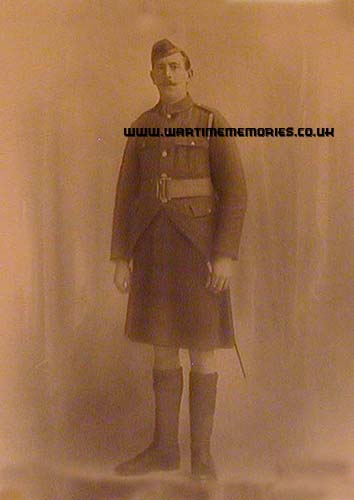Additions will be checked before being published on the website and where possible will be forwarded to the person who submitted the original entries. Your contact details will not be forwarded, but they can send a reply via this messaging system.
please scroll down to send a message
Pte. William "Postie" Nicoll
British Army 7th (Fife) Btn. Black Watch
from:St. Andrews
William Nicoll was born at 88 South Street in April 1885. His parents, Andrew and Isabella Nicoll, were descendants of fisher folk and can be traced back to Andrew Kipper c.1750, a shipwright who stayed at the Lady Head in the East End of St. Andrews. Most of his youth was spent in and around St. Andrews and Balmullo, where his father had a market garden. William was a founder member of the 1st St. Andrews Boy’s Brigade and was a member of the Colour Party at the laying of the foundation stone of the BB Hall. On leaving school, William started work as a postman delivering the mail in Leuchars and Ferry Port on Craig, now Tayport. During this time, he met and then married Agnes Gold Taylor, who worked in service in Tayport. They were married in Abdie Parish Church in 1910. They stayed for a time in North Street and then moved to 12 Southfield where 3 daughters and 3 sons were born. My father Joseph, the third oldest, was born in 1916.
At the outbreak of the First World War, William joined up with the 7th (Fife) Battalion, Black Watch. He was severely wounded at Passchendaele in 1917 and was admitted to No. 8 General Hospital Rouen on 22nd of October 1917 with gunshot wounds to thigh, hands, and left ankle. He spent almost 4 years in hospital in Glasgow and was visited regularly by Agnes, my grandmother, and their eldest daughter, my Auntie Nessie. On the first night of William’s return home to St. Andrews, my father asked my grandmother “Is that man going to stay here with us?” He had never seen him since he was a baby!
After recuperating at home, William returned to service in the post office in St. Andrews where he delivered mail from St. Andrews to Largoward, stopping at farms east and west of the Largo Road. This he did on foot, on bicycle, and with a pony and flat cart, 365 days a year. His favourite time was after the mail was safely delivered – on the way home he would stop at the top of The Waterless Brae, just north of Cameron Kirk road end, light his pipe, then freewheel all the way down the Largo Road home. Around 1933 or 34, William, Agnes, their 3 sons and 2 daughters (Auntie Nessie was now married) moved to 4 Cannongate just off Largo Road. William was a keen gardener, bred canaries, and owned greyhounds which he entered coursing. William also had a hen farm in the fields beyond the old railway, about where Broomfaulds Avenue is now. He also had a pony called Joe. I never found out whether the pony was named after my dad or vice versa!
In the first year of the Second World War, William was due to retire but was asked to fill the position of temporary postmaster for St. Andrews, which he held until the end of the war. For his service, he was able to secure a small pension for Agnes, my grandmother. William and Agnes’s three sons served in the war as did two of their daughters, and thankfully all returned home with no physical injuries. After the Second World War, William retired and worked part-time as a janitor at St. Leonards school where, I am told, the highlight of his day involved him lighting his pipe at the bottom of the St. Leonards clock and smoking it while he climbed the steps to wind the clock! He enjoyed his retirement and could always be found up at the hens or in his vegetable garden. Coursing with his greyhounds also took up his time, and he was the last winner of the Colinsburgh Cup after which he refused an offer of a blank check for the sale of the greyhound. My father told me how he never knew the extent of my grandfather's injuries until well after he was retired. My father would go to Cannongate in the morning to clean and light his fire for the day. Granddad asked my father on one occasion to help him sit up in bed. He noticed that part of his left thigh, buttock and hip were missing due to the injury he had sustained at Passchendaele. This didn't seem to hinder him in any way, and he must have been in pain for most of his adult life. What a remarkable and brave man my grandfather was! William died on 11th of November 1964.
